INTRODUCTION
Pediatric emergency medicine (PEM) is a relatively new specialty in Canada, first appearing as a Section of the Canadian Paediatric Society in 1986 but was only recognized by the Royal College of Physicians and Surgeons (RCPSC) as a subspecialty of pediatrics and emergency medicine (EM) without certification in 2000 and as a subspecialty with certification in 2006.Reference McGillivray and Jarvis 1 The Canadian Association of Emergency Physicians (CAEP) Academic Section was created in 2013 to promote high-quality emergency patient care through education and research. Improvements in EM practice benefit all Canadians, whether adult or pediatric patients, as the emergency department (ED) is often the access point to the medical system.
For the young, rapidly growing specialty of PEM, it is essential that resources and infrastructure are available to help academic programs further develop and to prepare our physicians, leaders, researchers, and educators to meet the many challenges of pediatric emergency care. There are not only new diagnostic tools and procedures to incorporate into practice but also pressures including ED crowding and resource limitations. Canadians would benefit from an investigation of current resources allotted to our academic PEM programs, in which young clinicians are trained and new evidence is generated. These programs are integral to improving the pediatric emergency health care of Canadians, who benefit from well-trained physicians, continuing education for these physicians, and high-quality evidence generated by clinician scientists.
There are four major areas of focus to support the mission of university academic departments: administration/leadership, education, research, and funding. The importance of education and its development were addressed at the 2013 CAEP Academic Section Consensus Conference on education scholarship. Recommendations were centred on improvements to teaching and learning, as well as the support and development of education scholars.Reference Sherbino, Van Melle and Bandiera 2 - Reference Bandiera, Leblanc and Regehr 4 The follow-up from the 2016 CAEP Academic Symposium on education entitled Emergency Physician Educators & Scholars … the Path to Success provided recommendations for training career educators, making an impact on education, and having scholarly work published.Reference Woods, Artz and Carrière 5 - Reference Frank, Cheung and Sherbino 7 The variability in infrastructure, support, and productivity for EM research programs across Canada was discussed at the 2014 CAEP Academic Symposium on research, at which recommendations were published to improve research funding, resident research supports, and training for career researchers.Reference Perry, Snider and Artz 8 - Reference Calder, Abu-Laban and Artz 11 Its 2017 follow-up symposium focused on recommendations to improve research through engagement, implementation, and knowledge translation (with published recommendations released in 2018). The 2015 Academic Symposium on leadership provided recommendations for current leaders, regarding leadership strategies, governance, and funding.Reference Petrie, Chopra and Chochinov 12 - Reference Lang, Artz and Wilkie 14
Although the need for these recommendations is generally accepted among academics, an environmental scan that characterizes each PEM unit in the areas of leadership, administration, education, research, and funding would clearly articulate to the individual sites their specific strengths to build on and weaknesses to address, when comparing themselves to the national averages. Indeed, an environmental scan of (adult) EM academic units was recently published and identified EM academic units without a university status.Reference Stiell, Artz and Lang 15 , Reference Stiell, Artz and Lang 16 Key areas of interest from the adult academic environmental scan considered in this pediatric environmental scan included the overarching administration of the academic unit to ensure that there is strength in the EM voice within the university. Funding and access to resources for education and research are necessary to achieve a productive academic unit.
The mission of the CAEP Academic Section is threefold: 1) to improve the emergency care of patients by enhancing academic EM primarily at Canadian medical schools and teaching hospitals; 2) to foster and develop education, research, and academic leadership among Canadian emergency physicians, residents, and students; and 3) to provide mentorship in academic EM. Two specific objectives within the terms of reference for the Section are to: 1) create a database of academic activities, physician leaders, infrastructure, and resources at each Canadian medical school; and 2) support academic EDs, divisions, or units at each medical school and teaching hospital to ensure the appropriate status, resources, and infrastructure. To achieve these goals and to assist sites in understanding their local strengths and weaknesses, we conducted an environmental scan of academic PEM activities at all Canadian medical schools and their associated major teaching hospitals.
METHODS
We developed an 88-item questionnaire (FluidSurveys, Ottawa, ON), focusing on four domains: governance/administration, education, research, and funding (see Supplemental Material). The survey was aligned with a recently published adult academic EM scan questionnaire.Reference Stiell, Artz and Lang 15 , Reference Stiell, Artz and Lang 16 It comprised of yes/no and numerical responses, as well as boxes for comments on specific practices or resources available in academic departments. It was pilot tested among members of the CAEP Academic Section Executive, including academic department heads, and revised for clarity. The final questionnaire was distributed electronically to the heads (or equivalent) of each PEM unit at the 17 Canadian medical schools.
All data were exported and assessed using a Microsoft Excel® 2013 (Microsoft Corp., Redmond, WA) spreadsheet for analysis. Descriptive statistics including proportions, means, medians, and ranges were calculated. The authors (J.A. and I.S.) reviewed all individual site data. Comprehensive individual site-specific tables were created that highlighted missing and internally inconsistent data. Individual site reports were sent by email to their respective respondents, who reviewed the data and provided updated information, as needed. Corrections were made based on the feedback received.
RESULTS
Three of the 17 medical schools were identified by the survey recipients as having no PEM academic program and were excluded from further analysis. Of the 14 remaining sites that had academic PEM programs, none had full departmental status at the university. Nine were divisions, two were sections, and three had no status (Table 1), in which the divisions and sections were predominately under the confines of the pediatric departments. Canadian academic PEM is conducted at 13 major teaching hospitals (defined as those that have a full complement of residency programs and a research institute) and one specialized pediatric ED hospital (i.e., a pediatric ED that is not part of a pediatric hospital) (Table 2). There are 13 full professors, 64 associate professors, and 109 assistant professors of PEM in Canada. In total, there are 394 faculty members if including professors and lecturers, as well as those with clinical appointments. Clerkships are offered at 8 of the 14 universities; all have off-service residents rotate through annually; and fellowship training is offered at 10 of the 14 (Table 3).
Table 1 University status of PEM
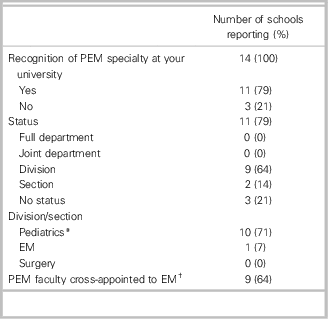
EM=emergency medicine; PEM=pediatric emergency medicine.
* One site specified that although they are officially within the pediatrics department, they have representation within the EM department.
† The percentage of faculty with cross-appointments to EM was 42% (ranging from 5% to 100%).
Table 2 Teaching hospitals and EM faculty
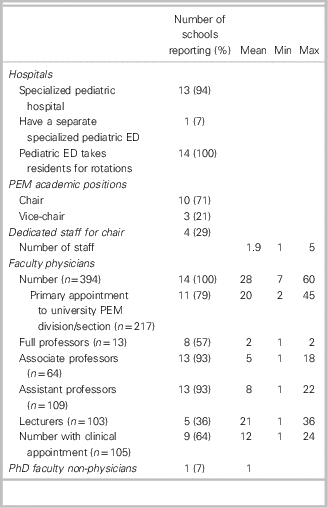
EM=emergency medicine; PEM=pediatric emergency medicine.
Table 3 Undergraduate, residency, and fellowship programs
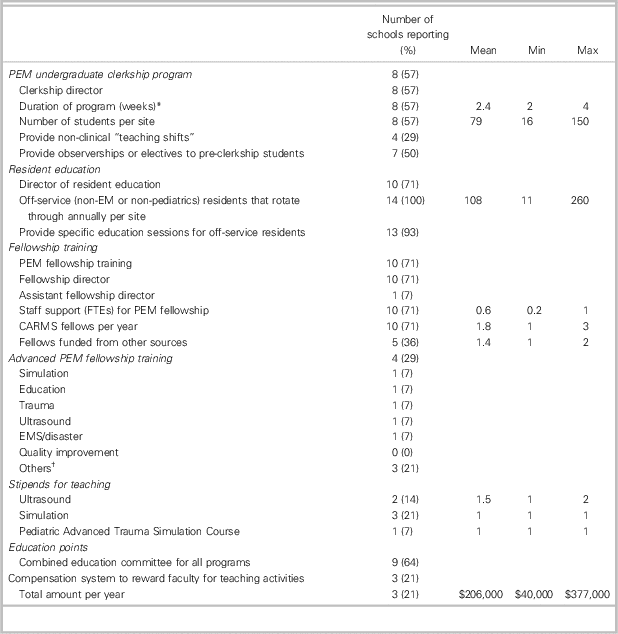
CARMS=Canadian Residency Matching Service; EM=emergency medicine; EMS=emergency medical services; FTEs=full-time equivalents; PEM=pediatric emergency medicine.
* One site indicated a longitudinal program taking place over 48 weeks (which is not included in the reported mean or range).
† Other advanced PEM fellowship training included research and global health.
Continuing professional development (CPD) and education scholarship are two important domains in Canadian academic EM (Table 4). Eight of the 14 sites report hosting an annual CPD conference, and 11 of the 14 have workshops and training courses for their own physicians. Ten of the 14 sites have CPD and continuing medical education outreach workshops for residents on rotation and outreach lectures and workshops at community hospitals. Across Canada, there are 18 PEM faculty members with graduate education degrees and 14 with formal education fellowships, representing 7 of the 14 and 6 of the 14 schools, respectively. Eleven have funding to carry out education scholarship at 5 of the 14 sites, with nine holding external peer-review salary awards for educational research and scholarship.
Table 4 Education scholarship and CPD
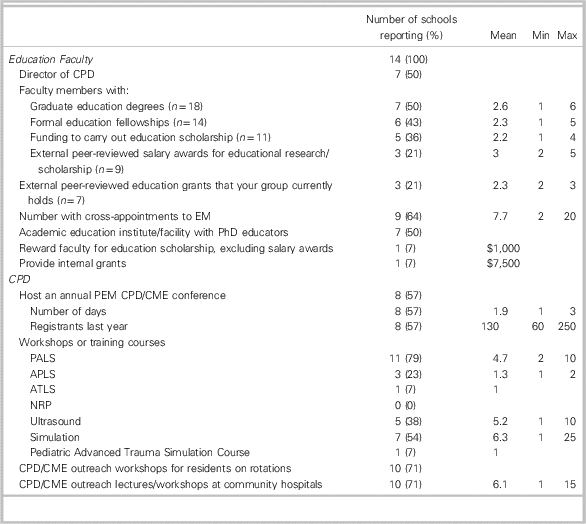
APLS=advanced pediatric life support; ATLS=advanced trauma life support; CME=continuing medical education; CPD=continuing professional development; EM=emergency medicine; NRP=neonatal resuscitation program; PALS=pediatric advanced life support; PEM=pediatric emergency medicine.
Research productivity is a key indicator of academic performance, and there are now 31 researchers with salary support based at nine universities (Table 5). Among these, five currently have external peer-reviewed salary awards, and 35 have external peer-review grants, including 18 held by a principle investigator from Canadian Institutes of Health Research or Heart and Stroke Foundation of Canada. Eleven sites have published peer-reviewed papers in the past five years, ranging from 2 to 102 per site. All 14 sites participate in Pediatric Emergency Research Canada (PERC).
Table 5 Research activities and resources
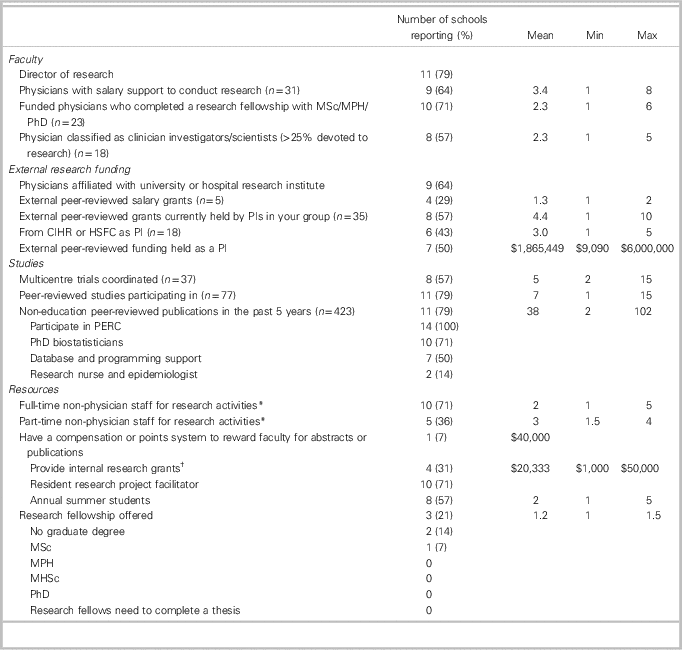
CIHR=Canadian Institutes of Health Research; HSFC=Heart and Stroke Foundation of Canada; PERC=Pediatric Emergency Medicine Canada.
* One site indicated that there are full- and part-time staff but did not indicate the number.
† One site indicated that there were internal research grants but did not provide a value.
Ten sites shared details of their academic funding (Table 6). The annual budgets vary greatly, from $10,000 to $2,607,515. Sources of funding also vary greatly, with 6 of the 10 reporting university funding, 2 of the 10 reporting hospital funding, 3 of the 10 reporting physicians and practice plans, 4 of the 10 reporting Ministry of Health and Alternate Funding Plans, and 3 of the 10 reporting other sources (including the local EM department, grants, and research institute).
Table 6 Budgets
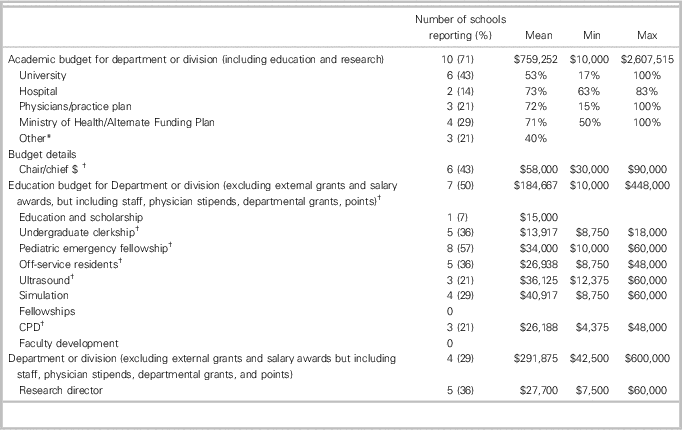
CPD=continuing professional development.
* Other sources of funding included a non-renewable lump sum from the local EM department, grants, and research institute support. Only one site attached a significant percentage of their funding to the other source.
† Not all sites reported a value, despite indicating the funded role.
DISCUSSION
This report is the first comprehensive review of academic PEM activities at Canadian medical schools and major teaching hospitals. It is a follow-up to an academic environmental scan on adult EM published in 2017.Reference Stiell, Artz and Lang 15 , Reference Stiell, Artz and Lang 16 We found that PEM has a presence in patient care and teaching at 14 of the 17 Canadian medical schools. While university status varies across the country, sites are involved in teaching: undergraduate clerkship programs (8), RCPSC residency programs for PEM (10), off-service residents (14), fellowships (10), and CPD (7). Education scholarship is becoming established, with some sites providing salary support for this endeavour. Clinical researchers in PEM have protected time at nine Canadian sites, and some groups have been successful with peer-reviewed funding and publications. Academic activities require funding, and there is a greater than 200-fold range in annual budgets among universities.
Overall, this report has found variability in Canadian academic EM, including sites with resources in areas in which other sites have none. PEM is a relatively new discipline, and its specialty status was recognized in the United States in 1991 and in Canada, the United Kingdom, Australia, and New Zealand nearly a decade later.Reference Babl, Weiner and Bhanji 18 Our report shows not only how far Canadian academic PEM has come in less than three decades, from 49 pediatricians practising without formal training in 1989 to nearly 400 subspecialists with academic affiliation in 2017, but also how far it has yet to go to be on equal footing with more traditional specialties such as medicine and surgery.Reference McGillivray and Jarvis 1 , Reference Pena and Snyder 17 , Reference Babl, Weiner and Bhanji 18 There are relatively few full professors of PEM, with some universities having none. While there are teaching activities across Canada, education scholarship and research have much room for growth at many sites, as compared with the highest performing sites in Canada. Three sites do not offer PEM training programs. Our scan identified university governances, with none reporting full departmental status and three reporting no status at all for their program. The appropriate governance structure for a subspecialty is outside the scope of this work. While unclear, data from the United States show that establishment of academic EM departments is strongly associated with many positive academic metrics.Reference Gallagher and Henneman 19 , Reference Derlet 20 The current report will serve as a benchmark against which to judge the future progress of academic EM in Canada.Reference Carpenter, Cone and Sarli 21
Moving forward, we anticipate that benchmarks and lessons learned from those sites performing above the national average can be used for direction and goal setting at those sites looking to implement change. Staff members or administrators of each emergency medicine unit could know how it compares to the national average, identify their areas of relative weakness (relative to the national standard), and set priorities for change. In some cases, these data can be used in discussions with university leadership to argue for elevated status, higher budgets, or more teaching and research positions. To this end, CAEP has funded consultations for Canadian academic EM units, with expertise provided by the Academic Section in governance funding, education scholarship, and research. Feedback from the consultation visits to adult academic EM units uniformly reflects the positive influence of the guidance provided by the CAEP academic consultation and previous environmental scan.Reference Stiell, Artz and Lang 15 , Reference Stiell, Artz and Lang 16 , 22
Why do our findings matter to Canadian pediatric emergency physicians? PEM, based at the universities and teaching hospitals, has extensive influence on ED care across Canada. The quality of the medical school and postgraduate training influences the careers of pediatric emergency physicians, so offering the best education is of paramount importance. An environmental scan captures the national averages and ranges that, in turn, affords individual sites the ability to assess their commitment to academics and seek additional support.
CONCLUSIONS
This report provides a comprehensive review of academic activities in PEM across Canada, identifying the variability, benchmarks set by high-performing sites, and opportunities for growth for sites below the national average. By sharing academic practices, CAEP, the Academic Section, and all Canadian PEM academic units will recognize the variabilities; be able to set standards for teachers, educators, and researchers; and, ultimately, improve patient care in our EDs.
Acknowledgements: We particularly thank Angela Marcantonio from the Ottawa Hospital Research Institute and Kelly Wyatt from CAEP. In addition, we are very grateful for the cooperation of EM leaders from each university: British Columbia (Garth Meckler), Alberta (Bruce Wright), Calgary (Angelo Mikrogianakis), Saskatchewan (Vicki Cattell), Manitoba (Scott Sawyer), Western (Rod Lim and Gary Joubert), McMaster (Anthony Crocco), Toronto (Jason Fischer), Ottawa (Gina Neto), McGill (Harley Eisman), Montreal (Antonio D’Angelo), Laval (Mathieu Blanchet and Christian Godin), Dalhousie (Shannon MacPhee), and Memorial (Robert Porter and Kevin Chan).
Competing interests: None declared.
SUPPLEMENTARY MATERIAL
To view supplementary material for this article, please visit https://doi.org/10.1017/cem.2017.437








